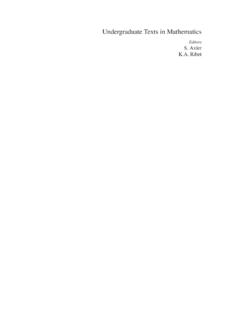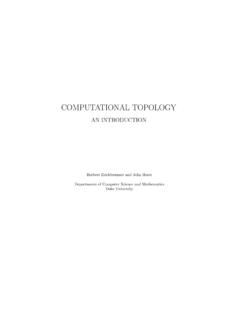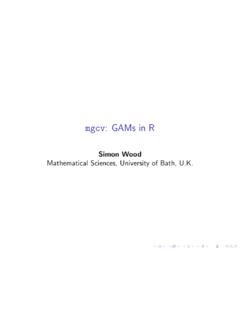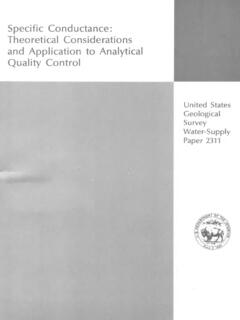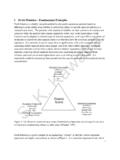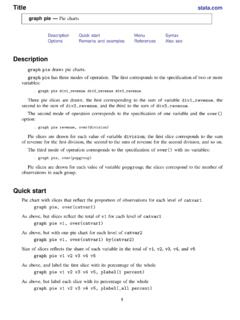Transcription of Chapter 2 Complex Analysis - School of Mathematics
1 Chapter 2. Complex Analysis In this part of the course we will study some basic Complex Analysis . This is an extremely useful and beautiful part of Mathematics and forms the basis of many techniques employed in many branches of Mathematics and physics. We will extend the notions of derivatives and integrals, familiar from calculus, to the case of Complex functions of a Complex variable. In so doing we will come across analytic functions, which form the centerpiece of this part of the course. In fact, to a large extent Complex Analysis is the study of analytic functions. After a brief review of Complex numbers as points in the Complex plane, we will first discuss analyticity and give plenty of examples of analytic functions.
2 We will then discuss Complex integration, culminating with the generalised Cauchy Integral Formula, and some of its applications. We then go on to discuss the power series representations of analytic functions and the residue calculus, which will allow us to compute many real integrals and infinite sums very easily via Complex integration. Analytic functions In this section we will study Complex functions of a Complex variable. We will see that differentiability of such a function is a non-trivial property, giving rise to the concept of an analytic function. We will then study many examples of analytic functions. In fact, the construction of analytic functions will form a basic leitmotif for this part of the course.
3 The Complex plane We already discussed Complex numbers briefly in Section The emphasis in that section was on the algebraic properties of Complex numbers, and 73. although these properties are of course important here as well and will be used all the time, we are now also interested in more geometric properties of the Complex numbers. The set C of Complex numbers is naturally identified with the plane R2 . This is often called the Argand plane. Given a Complex number z = x+i y, its real and imag- 6. inary parts define an element (x, y) of R2 , as shown in z = x + iy y the figure. In fact this identification is one of real vec- 7. tor spaces, in the sense that adding Complex numbers and multiplying them with real scalars mimic the simi- - lar operations one can do in R2.
4 Indeed, if R is real, x then to z = ( x) + i ( y) there corresponds the pair ( x, y) = (x, y). Similarly, if z1 = x1 + i y1 and z2 = x2 + i y2 are com- plex numbers, then z1 + z2 = (x1 + x2 ) + i (y1 + y2 ), whose associated pair is (x1 + x2 , y1 + y2 ) = (x1 , y1 ) + (x2 , y2 ). In fact, the identification is even one of euclidean spaces. Given a Complex p number z = x + i y, its modulus 2 . |z|, defined by |z| = zz , is given by x2 + y 2 which is precisely the norm k(x, y)k of the pair (x, y). Similarly, if z1 = x1 + i y1 and z2 = x2 + i y2 , then Re(z1 z2 ) = x1 x2 + y1 y2 which is the dot product of the pairs (x1 , y1 ). and (x2 , y2 ).
5 In particular, it follows from these remarks and the triangle inequality for the norm in R2 , that Complex numbers obey a version of the triangle inequality: |z1 + z2 | |z1 | + |z2 | . ( ). polar form and the argument function Points in the plane can also be represented using polar coordinates, and this representation in turn translates into a representation of the Complex numbers. z = rei p Let (x, y) be a point in the plane. If we define r =. r 7 x2 + y 2 and by = arctan(y/x), then we can write (x, y) = (r cos , r sin ) = r (cos , sin ). The Complex number z = x + i y can then be written as z = r (cos +. i sin ). The real number r, as we have seen, is the modulus |z| of z, and the Complex number cos + i sin has unit modulus.
6 Comparing the Taylor series for the cosine and sine functions and the exponential functions we notice that cos +i sin = ei . The angle is called the argument of z and is written arg(z). Therefore we 74. have the following polar form for a Complex number z: z = |z| ei arg(z) . ( ). Being an angle, the argument of a Complex number is only defined up to the addition of integer multiples of 2 . In other words, it is a multiple-valued function. This ambiguity can be resolved by defining the principal value Arg of the arg function to take values in the interval ( , ]; that is, for any Complex number z, one has < Arg(z) . ( ). Notice, however, that Arg is not a continuous function: it has a discontinuity along the negative real axis.)
7 Approaching a point on the negative real axis from the upper half-plane, the principal value of its argument approaches , whereas if we approach it from the lower half-plane, the principal value of its argument approaches . Notice finally that whereas the modulus is a multiplicative function: |zw| = |z||w|, the argument is additive: arg(z1 z2 ) =. arg(z1 ) + arg(z2 ), provided that we understand the equation to hold up to integer multiples of 2 . Also notice that whereas the modulus is invariant under conjugation |z | = |z|, the argument changes sign arg(z ) = arg(z), again up to integer multiples of 2 . Some important subsets of the Complex plane We end this section with a brief discussion of some very important subsets of the Complex plane.
8 Let z0 be any Complex number, and consider all those Complex numbers z which are a distance at most away from z0 . These points form a disk of radius centred at z0 . More precisely, let us define the open -disk around z0 to be the subset D (z0 ) of the Complex plane defined by D (z0 ) = {z C | |z z0 | < } . ( ). Similarly one defines the closed -disk around z0 to be the subset D (z0 ) = {z C | |z z0 | } , ( ). which consists of the open -disk and the circle |z z0 | = which forms its boundary. More generally a subset U C of the Complex plane is said to be open if given any z U , there exists some positive real number > 0 (which can depend on z) such that the open -disk around z also belongs to U.
9 A set C is said to be closed if its complement C c = {z C | z 6 C} that is, all 75. those points not in C is open. One should keep in mind that generic subsets of the Complex plane are neither closed nor open. By a neighbourhood of a point z0 in the Complex plane, we will mean any open set containing z0 . For example, any open -disk around z0 is a neighbourhood of z0 . Let us see that the open and closed -disks are indeed open and closed, respectively. Let z D (z0 ). This means that |z z0 | = < . Consider the disk D (z). We claim that this disk is contained in D (z0 ). Indeed, if |w z| < then, |w z0 | = |(w z) + (z z0 )| (adding and subtracting z).
10 |w z| + |z z0 | (by the triangle inequality ( )). < + . = . Therefore the disk D (z0 ) is indeed open. Consider now the subset D (z0 ). Its complement is the subset of points z in the Complex plane such that |z z0 | > . We will show that it is an open set. Let z be such that |z z0 | = > . Then consider the open disk D (z), and let w be a point in it. Then |z z0 | = |(z w) + (w z0 )| (adding and subtracting w). |z w| + |w z0 | . (by the triangle inequality ( )). We can rewrite this as |w z0 | |z z0 | |z w|. > ( ) (since |z w| = |w z| < ). = . Therefore the complement of D (z0 ) is open, whence D (z0 ) is closed. We should remark that the closed disk D (z0 ) is not open, since any open disk around a point z at the boundary of D (z0 ) that is, for which |z z0 | = contains points which are not included in D (z0 ).
